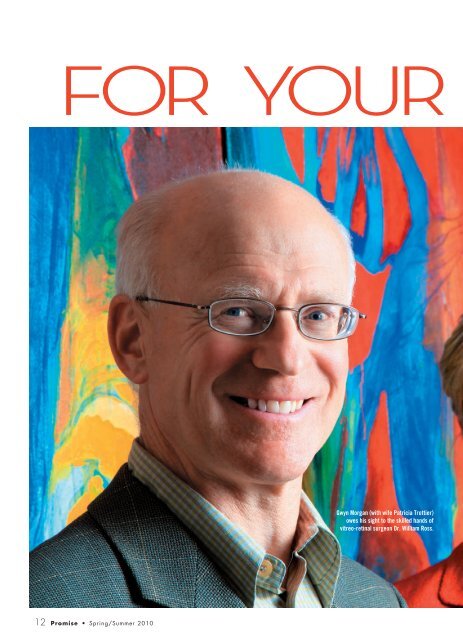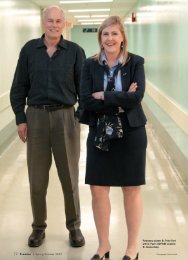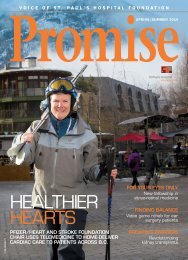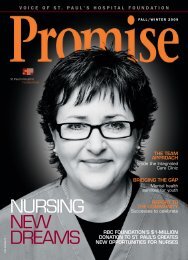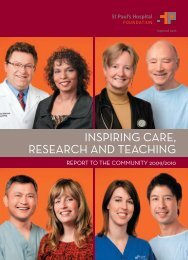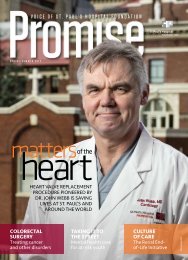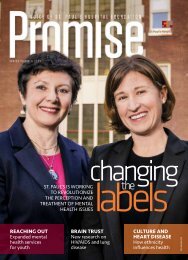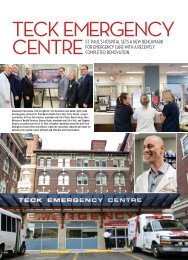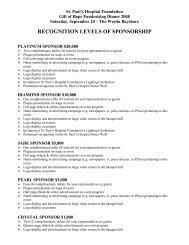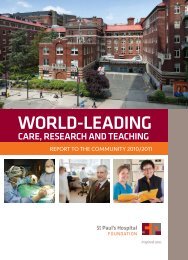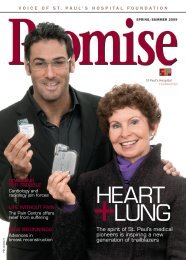For Your Eyes Only - St. Paul's Hospital Foundation
For Your Eyes Only - St. Paul's Hospital Foundation
For Your Eyes Only - St. Paul's Hospital Foundation
- No tags were found...
Create successful ePaper yourself
Turn your PDF publications into a flip-book with our unique Google optimized e-Paper software.
for yourGwyn Morgan (with wife Patricia Trottier)owes his sight to the skilled hands ofvitreo-retinal surgeon Dr. William Ross.12 Promise • Spring/Summer 2010
eyes onlyby yolanda brooksA gift of thanks from agrateful patient creates theWilliam H. Ross Fellowshipfor Vitreo-Retinal ExcellenceWhen Gwyn Morgan lost the sight in his right eye aftera surfing accident in 1995, the founding presidentand former CEO of energy giant EnCana Corp.continued to enjoy challenging outdoor activities, such as mountainrunning and deep-powder skiing. But last spring, a few hoursafter a run while on a visit to Britain, large, dark spots began tocloud the vision in his good eye.“The loss of sight in one eye is not something you want to celebrate, but there isa whole lot of difference between losing one and losing the second one,” reveals thesoft-spoken Morgan. “It was reminiscent of the accident I had 15 years ago, so of courseI was extremely anxious because it seemed like it was occurring all over again.”After assurances from U.K. ophthalmologists that the condition was stable in theshort term, Morgan asked them to recommend a retinal specialist in Canada. Theyrecommended Dr. William H. Ross – a vitreo-retinal surgeon at <strong>St</strong>. Paul’s <strong>Hospital</strong> anddirector of Providence Health Care’s Retina Service. Dr. Ross has been involved inclinical research and teaching, as well as caring for patients with retinal diseases, overthe last 36 years. He has helped make <strong>St</strong>. Paul’s Department of Ophthalmology one ofthe best in North America.On his return home to B.C., Morgan immediately became Ross’ patient. Afterseveral months of laser treatment to stabilize Morgan’s eye, Ross was able to performsurgery and save his sight.Fellowship programAs a regular visitor to the <strong>St</strong>. Paul’s <strong>Hospital</strong> Eye Clinic, Morgan was able to observeRoss tending to other patients. He also learned about the fellowship program thatwas developed in 1985 by Ross and Dr. Alan Maberley of Vancouver General <strong>Hospital</strong>.Since then, this University of B.C. (UBC) fellowship has trained 39 vitreo-retinal fellowsand gained an international reputation for excellence in training fellows in this area.“These post-graduate fellows are outstanding individuals and we have the pleasureof helping them reach the next level,” says Ross. “We teach them our diagnostic andsurgical skills so that they leave as excellent vitreo-retinal specialists who can deal withthe most difficult problems and help people wherever they go.”Moreover, Ross and his UBC colleagues, with the help of occasional outside donations,have funded the fellowship themselves.Gwyn Morgan and his wife, community leader Patricia Trottier, had already set upa foundation to support various education initiatives. They decided that funding theWilliam H. Ross Fellowship in Vitreo-Retinal Excellence would be the ideal way toshow their appreciation for the care Morgan received at <strong>St</strong>. Paul’s <strong>Hospital</strong>.Through their Gwyn Morgan and Patricia Trottier <strong>Foundation</strong>, the couple made a$1.375-million commitment to support the funding of one fellow for each of the next25 years.“Education is a key area for us,” says Trottier. “By funding the fellowship, Dr. Rosscan continue to share his knowledge and expertise with others.”<strong>For</strong> Ross and his UBC colleagues, it means that the advanced learning opportunityhe and Maberley set in motion 25 years ago will continue long after Ross retires: “Thefellowship is an honour for me and my colleagues and ensures we can continue to trainexcellent vitreo-retinal specialists. I am humbled by their generosity.”Photograph: Ron SanghaSpring/Summer 2010 • Promise 13
Dr. Andrew Kirker, from Calgary, Alberta,is the first William H. Ross Fellow in Vitreo-Retinal Excellence. The former UBC medicalstudent is more than halfway through thefellowship and is relishing the opportunity.“The fellowship is world-renownedfor good surgical training and you get a lotof experience in one year,” says Kirker. “I amdefinitely getting exceptional training, andDr. Ross is a vibrant, high-energy gentleman,so you learn a lot but you also have a lot of fun.”Dr. Amir Guerami is another fellow currentlylearning from, and working with, Rossat <strong>St</strong>. Paul’s.“This fellowship has a reputation in the<strong>St</strong>ates for being very surgically strong,” saysGuerami. “Patients are referred from all overB.C., so the Providence Health Care Departmentof Ophthalmology at <strong>St</strong>. Paul’s is avery busy place. Because you pretty muchsee everything, you are getting years’ worthof experience.”The long-term prognosis for Gwyn Morganlooks good and, between his directorships andcharitable works, he’s back to a full and activelife. In contemplating the fellowship, he says,“Giving an award to Dr. Ross personallywouldn’t have been important to him. To helphim in his work and support the fellows thathe is so dedicated to is the most important thingwe could do for Dr. Ross, and that just says alot about him. He is a very special guy.” nDr. William Ross (left) with a patient; (right) with the first William H. Ross Fellow in Vitreo-Retinal ExcellenceDr. Andrew Kirker.Second Chance at SightAbout a year ago, Mike Clarke lay dying in a darkenedcar park in Powell River on the Sunshine Coast. Onthe emergency helicopter ride to hospital, his heartstopped three times.His head injuries were so severe that he was in acoma for a month, but when he regained consciousness,he had little to celebrate. He couldn’t walk and he hadlost his sense of taste and smell. He was also blind inboth eyes because hemorrhaging from his head traumawas leaking onto his optic nerve.Since the incident, Clarke has been making asteady recovery and has learned to walk again. Butdoctors told him he would never regain his sight and,not surprisingly, he became very depressed.The turning point for Clarke came in October oflast year, when Dr. William Ross operated to give himback the sight in his right eye.“It made a huge difference,” says Clarke. “Thedepression went away when I was able to see. I didn’tmind not being on my feet, or not being able to smell ortaste anything, but not being able to see – I wouldn’twish that on anyone.”After a second operation on his left eye in December,Clarke looks forward to regaining his full sight andmore independence.“Just being able to see is amazing to me. I can read,use the cellphone and computer and see a TV screen. I willbe able to drive again. Dr. Ross is an awesome doctor.” lVitreo-retinal DiseasesAge-related macular degeneration diabetic retinopathy detached retinaVitreo-retinal diseases affect the vitreous (the jelly-likefluid in the middle of the eye) and the retina (the lightsensitivemembrane that lines the back of the innereye). With our rapidly aging population, vitreo-retinalconditions are becoming more widespread.Age-related macular degeneration: Age-relatedmacular degeneration (AMD) is the most commoncause of loss of vision in people over 65. The mostserious form, wet AMD, is caused by abnormal bloodvessels growing beneath the retina and leaking fluidonto the macula (the central part of the retina). Thisleads to loss of central vision.Until five years ago there was no treatment for thecondition and sufferers were rendered legally blind.However, two drugs are now available to treat AMD.“With the use of these new drugs, 35 per cent ofpatients with wet macular degeneration are able todrive and read again,” explains Dr. William H. Ross,director of Providence Health Care’s Retina Serviceand clinical professor of Ophthalmology at UBC.Diabetic retinopathy: With the growingincidence of Type 2 diabetes, <strong>St</strong>. Paul’s Eye Clinic isseeing more patients with diabetic retinopathy. Bloodvessels in the back of the eye bleed onto the retina orvitreous causing blindness. Symptoms appear about15 to 20 years after the first diagnosis and requireregular monitoring. Laser treatment and vitrectomysurgery are the most common types of treatment.Detached retina: A detached retina is anothersign of aging of the eye. As the vitreous shrinks withage it detaches from the retina, which can sometimespull the retina from the wall of the eye leading to lossof vision. Immediate surgery is the only cure. l<strong>St</strong>. Paul’s exceptional caregivers, educators and scientists,including Dr. William Ross, need your continued support. <strong>For</strong>more information about how you can help foster <strong>St</strong>. Paul’s<strong>Hospital</strong>’s unique environment of innovation, mentorship andcare, visit www.helpstpauls.com or call 604-682-8206.14 Promise • Spring/Summer 2010Photographs: Brian Smith (Dr.Ross); i<strong>St</strong>ockphoto (detached retina)


